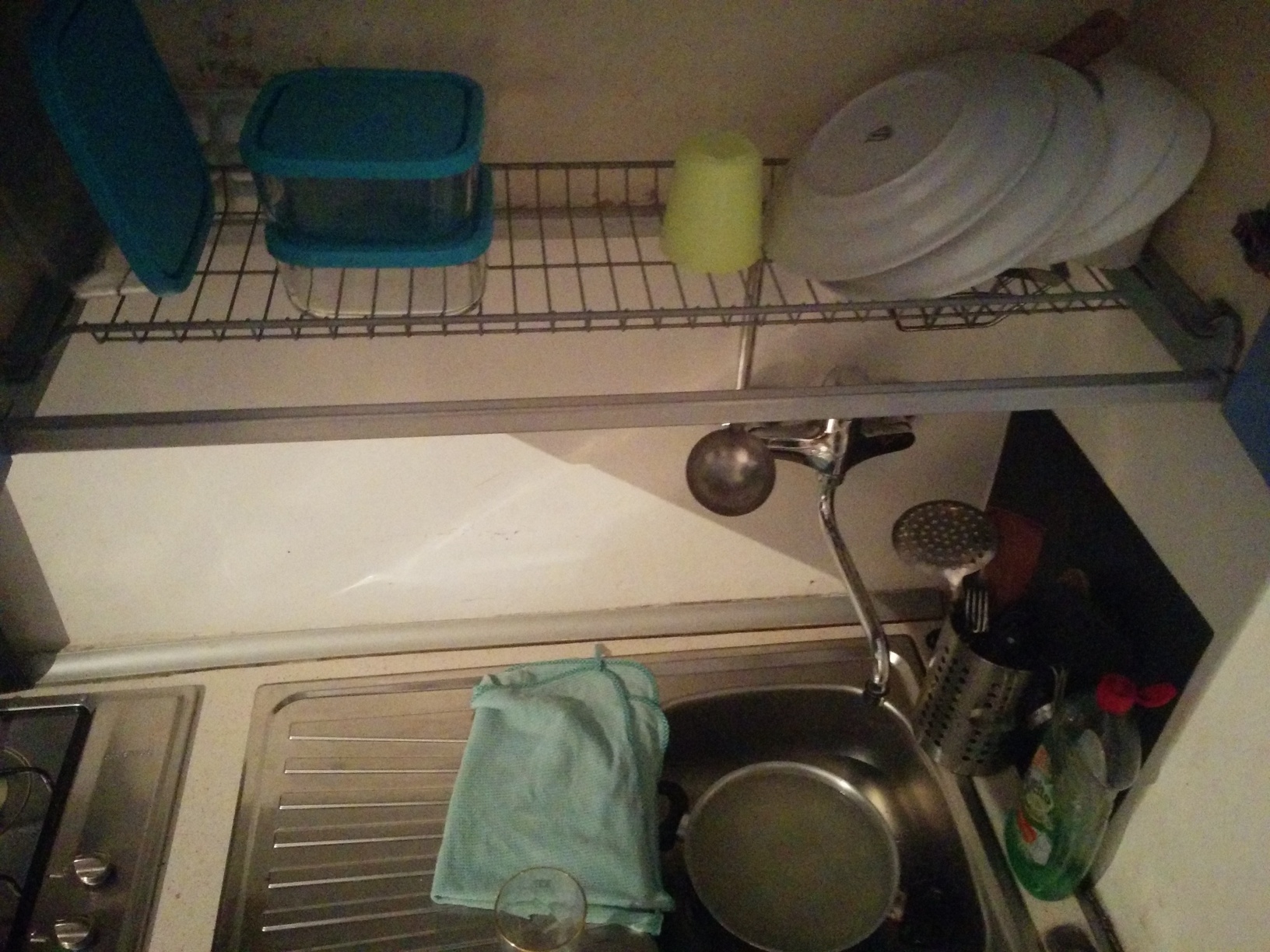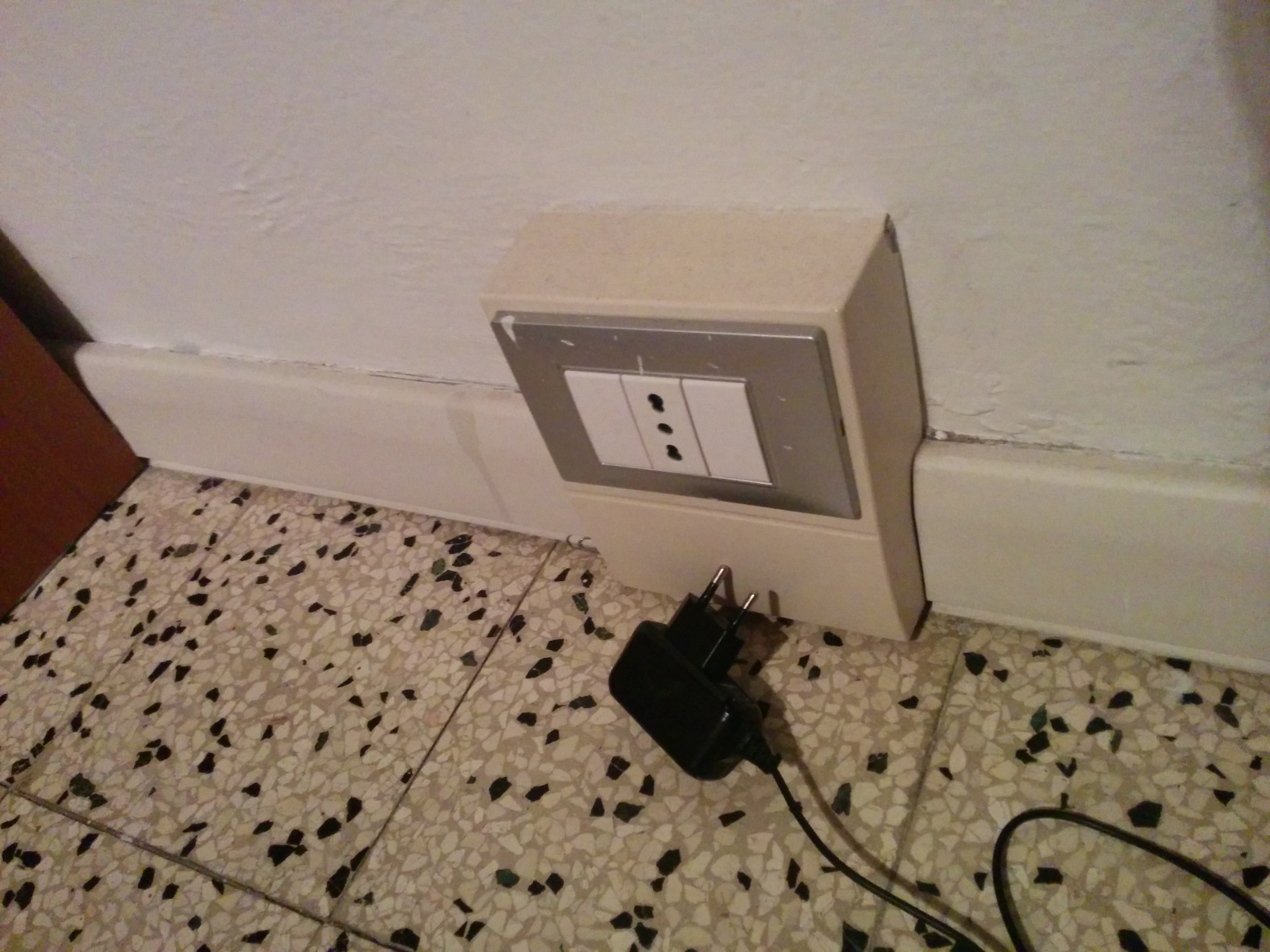We’ve been in Italy for 3-1/2 weeks now, so we’re starting to get a handle on (at least northern) Italian culture. You might think of pasta and pizza or art and churches, and you wouldn’t exactly be wrong, but that would be like boiling down American culture to grilled hamburgers and 4th of July fireworks.
So just like I described some everyday things in Ireland 2-1/2 months ago (Has it really been that long?!), I’m going to do the same for Italy.
In the Kitchen
I may as well start off the same way I did in my Ireland post.
- The refrigerators
 are similar to Ireland and the rest of what we’ve seen in Europe so far. I’m struggling to remember how we filled up so much space in the US. One common curiosity we’ve seen all over Italy is that the fridges are often made to look like the rest of the cabinetry, as shown here.
are similar to Ireland and the rest of what we’ve seen in Europe so far. I’m struggling to remember how we filled up so much space in the US. One common curiosity we’ve seen all over Italy is that the fridges are often made to look like the rest of the cabinetry, as shown here. - In Ireland, the oven used a “gas mark” system to denote temperature. Here, it’s simply in degrees Celsius. So while it required a conversion for N to cook her cauliflower dish, at least I didn’t have to read a Wikipedia article. Lighting the stove is similarly childproof (and sometimes adult-proof), typically requiring one to hold down the burner, press a button, wait for the flame, and then keep holding it for a while, lest the fire immediately go out.
- Italian kitchens include an idea
 so simple and yet so brilliant that I’m surprised we haven’t seen it anywhere else: the over-the-sink-cabinet-drainer. Most of the places we’ve stayed have these. After washing your most commonly-used dishes, you just put them directly away, where they drip into the sink below. No need for drainers or towels or handling dishes multiple times. They’re done!
so simple and yet so brilliant that I’m surprised we haven’t seen it anywhere else: the over-the-sink-cabinet-drainer. Most of the places we’ve stayed have these. After washing your most commonly-used dishes, you just put them directly away, where they drip into the sink below. No need for drainers or towels or handling dishes multiple times. They’re done! - Every apartment we stayed in across Europe—Ireland, Denmark, Sweden, and Poland—included an electric kettle for heating water for tea. In Galway, Ireland, the apartment manager even bought a new one for the unit within hours of the old one shorting out! Italy has been the first country without them, and tea is much less common. Most people here drink coffee, instead.
Dining in Italy
- Italians prefer coffee to tea,
 but if you’re imagining a mug full of a dark brew, you’ve got the wrong idea. Italians always drink espresso, and if you’re picturing a shot of espresso, you’re right, that’s all there is! This one that I’m drinking is actually an espresso doppio (double), so it’s bigger than usual. But it sure is good!
but if you’re imagining a mug full of a dark brew, you’ve got the wrong idea. Italians always drink espresso, and if you’re picturing a shot of espresso, you’re right, that’s all there is! This one that I’m drinking is actually an espresso doppio (double), so it’s bigger than usual. But it sure is good! - Italians love coffee so much that one bullet point wasn’t enough. Some opt for cappuccino in the morning, but putting milk in your coffee after lunch is a big faux pas, though many people take sugar. Even without milk, their coffee is a frothy, brown color, rather than the black stuff we have. Speaking of milk, the Italian word for it is latte. So don’t order a “latte” in Italy, or you might just get a glass of milk and some weird looks.
- As is the case in much of Europe, drinking coffee or tea with your meal is a bit strange. In Italy, though, drinking anything but water or wine with dinner is practically unheard of, unless you’re having a beer with pizza. The good news is that the wine is incredibly affordable: at most (non-tourist-trap) restaurants, you’re looking at about €12-16 ($15-20) for a bottle.
- If you do order water,
 expect to choose either naturale or frizzante, because it’s coming in a bottle. Everyone eating out gets bottled water, usually in 0.75-1L bottles that are shared. Tap water is practically unheard of, even though it’s all quite good. Many of the big cities actually have nice drinking fountains that are constantly putting out delicious water for everyone to drink.
expect to choose either naturale or frizzante, because it’s coming in a bottle. Everyone eating out gets bottled water, usually in 0.75-1L bottles that are shared. Tap water is practically unheard of, even though it’s all quite good. Many of the big cities actually have nice drinking fountains that are constantly putting out delicious water for everyone to drink. - Water isn’t the only thing you might be surprised to pay for at dinner. If you go out in a touristy area, you’re likely to be charged a coperto, a €1-3 charge per person, just for eating out. On the other hand, tipping is generally not expected: staff are very happy to be given a €50 note for a €46 meal.
- Eating out must be planned, as restaurant kitchens are generally closed from about 2 PM to 7 PM, though there are a few exceptions.
There’s plenty more to say about food, but I better finish up this post before I get too hungry!
Around the House
- Quick trivia: What’s this?
 If you said “sink”, well, I hope you didn’t brush your teeth there. It’s a bidet! So far, every bathroom has one in homes and hotel rooms. After wiping, you turn on the water, use a bit of soap, and clean yourself more thoroughly. How do I know this? Because I did a lot of research before I worked up the nerve to use one. And yes, all of those links are actually from my browser history.
If you said “sink”, well, I hope you didn’t brush your teeth there. It’s a bidet! So far, every bathroom has one in homes and hotel rooms. After wiping, you turn on the water, use a bit of soap, and clean yourself more thoroughly. How do I know this? Because I did a lot of research before I worked up the nerve to use one. And yes, all of those links are actually from my browser history. - Right now, I happen to be laying in a queen size bed. This is the first one we’ve encountered in all of Italy. Literally. Every other room has either been two entirely separate twin beds, or two twin mattresses pushed together, masquerading as a bigger bed. Sharing a bed like that is like trying to ride a two-person horse costume. I will sleep well tonight.
- In my Ireland post
 I showed a power outlet. This is Italy’s, which is the same as Denmark, Sweden, Poland, and most of the rest of Europe. Fortunately, the adapter that N brought along has worked for everything so far.
I showed a power outlet. This is Italy’s, which is the same as Denmark, Sweden, Poland, and most of the rest of Europe. Fortunately, the adapter that N brought along has worked for everything so far. - TVs are much rarer and much smaller here than in the US. About half the places we’ve stayed don’t have one at all. Most of the rest are small, old school varieties that have a smaller screen than my laptop while being the size of a small microwave. Only one of our hosts, an older gentleman, even watched TV while we were there.
Around Town
- In Denmark, pedestrians often waited for the light even if no cars were coming. That is not the case in Italy: if no cars are coming, people—old and young alike—cross the street. Why wait?
- If you are ever buying produce in Italy, don’t pick it up! You will almost certainly get dirty looks. In supermarkets, you must first put on gloves, and at produce stands, you point and ask. It applies to more than produce, too—some street vendors selling frozen treats had signs telling people not to serve themselves.
- Store hours can be a bit hard to get used to. Grocery stores generally close during lunch. Most restaurants close between 15:00 and 19:00 (oh, and Europe mostly uses times that go from 0-24). When you realize that many of the businesses are run by just a few people, it makes a lot more sense. Grocers close at lunch so they can eat. Restaurants close so that the chefs have time to buy the ingredients for dinner once the grocers return to work. And some shopkeepers have strange hours, mainly because they are returning to work upwards of 3 times throughout the day while still managing to spend time with friends and family over lunch and dinner.
Many tourists are annoyed by that last point, but for hard-working Italians these breaks are vital parts of their days. And with one of the highest life expectancies, over three years longer than the US, they must be doing something right.



I was in Aviano Italy for 2 years, very cool around there and only 45 minutes from Venice